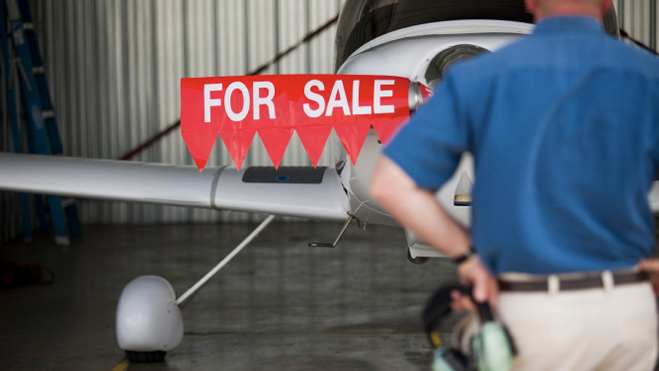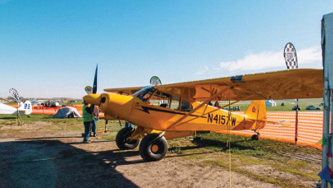
Pilot Information Center
Planning to buy?
There’s a boom going on; get in on it
One might think aircraft sales would decrease during a global pandemic, but that hasn’t exactly been the case. Although sales of new turbine and larger aircraft fell in the past year, sales of new piston aircraft held their own in 2020. Sales of used airplanes are up, and the values for used aircraft are up significantly. In the past few months, AOPA’s Pilot Information Center has been busy fielding hundreds of calls from members interested in buying aircraft.
GA’s numbers are holding strong through this boom. In fact, we’ve seen increased flight hours, fuel sales, and on some days, more Cessna 172s in the air than Boeing 737s. More leisure time has many itching for new activities, including reaching for their pilot certificates and filling up flight schools.
Many who are diving into these recreational activities are also first-time buyers. A comprehensive list of available resources for potential buyers is on the AOPA website, and AOPA recently launched its Aircraft Guide, which spotlights new aircraft ranging from single-engine pistons and twins to turbines and rotorcraft.
Resources
- Prepurchase inspection tips
A prebuy inspection on an aircraft is the chance to research and investigate every aspect of a potential investment. The prebuy should include a thorough inspection of the mechanical as well as cosmetic condition of the aircraft. - Vref aircraft valuation service
Use AOPA’s aircraft valuation service, provided by Vref, to perform an aircraft valuation online. Find out about aircraft value, typical add-on equipment, performance and specs, engine data, and more. - Financing
AOPA Aviation Finance is available to help members find the right financing for new and used general aviation aircraft. - Title and escrow services
Know the history of the aircraft with formal title and accident/incident reports. Aero-Space Reports offers AOPA members a discount on aircraft title and escrow services. - Insurance options
AOPA’s partner for aviation insurance, AssuredPartners Aerospace offers AOPA membership discounts. - Legal guidance
If you’re thinking about buying or selling an airplane, or you need guidance on how to set up a corporation or limited liability company for your aircraft, AOPA has a national network of more than 650 panel attorneys who can help you and your accountant through the process based on the applicable state laws that may apply. (See aopa.org/pps for Pilot Protection Services benefits.) - Forms
Access forms you’ll need, including aircraft registration (AC Form 8050-1); aircraft bill of sale (AC Form 8050-2); information if registering aircraft in an LLC; and a sample aircraft purchase/sales agreement. - Aircraft Guide
Learn more about individual aircraft with AOPA’s detailed reports on a vast variety of in-production GA aircraft. - Aircraft Fact Sheets
Used general aviation aircraft information gathered together in one spot.

Air Safety Institute
Faulty assumptions
Avoiding fuel exhaustion
By Alicia Herron
Ah, yes, weight and balance: the constant juggling act of getting what we want into the airplane and the performance we need out of it, all while staying within a tidy and fixed envelope. And when required gear (suitcases, survival kit, and more) and passengers are non-negotiable, pilots often turn to fuel to come out below maximum gross weight. But sometimes, we push it too far—fuel exhaustion accidents continue to occur every year.
Of all the factors that lead to aircraft accidents, fuel is one of the easiest to address. If you know your fuel system, verify that you have the right type and quantity of fuel, lean the engine properly, and stay alert to changing conditions, the odds of a fuel-related incident are virtually nonexistent.
Here are some tips to avoid fuel exhaustion:
- Be present every time your aircraft is fueled. Verify fuel grade, quantity, and tanks to be filled (see “Savvy Maintenance: Misfueled!” p. 96).
- Check for water or contaminants in your tanks.
- Secure fuel caps after you check the tank and doublecheck them before engine start.
- Determine available fuel in hours and minutes instead of gallons and pounds, and plan to land with at least an hour of usable fuel.
- Lean the mixture to achieve the best performance, range, and endurance.
- Recalculate range and endurance hourly to maintain adequate fuel reserves.
- Understand how and when to use boost pumps, auxiliary tanks, and fuel transfer pumps, and switch tanks before reaching pattern altitude.
- Use a timer to remind you to switch tanks during flight.
- If you do become low on fuel, land as soon as possible, and if you get close to running out, don’t be shy or embarrassed—declare a fuel emergency with ATC to get priority handling.
This may seem overly straightforward, but even experienced pilots make mistakes with fueling, sometimes with severe consequences. In the early morning light of April 22, 2019, the pilot of a Beechcraft Baron 58 preflighted his aircraft at West Houston Airport in Texas, before heading to the terminal to greet his five passengers. The flight was planned to take just more than one hour. But the pilot’s mistaken belief about existing onboard fuel proved disastrous.
Join the AOPA Air Safety Institute in the video Accident Case Study: Faulty Assumptions (airsafetyinstitute.org/ACS/faultyassumptions) as we follow the Baron’s flight and learn how an unfortunate chain of events ultimately led to tragedy.
airsafetyinstitute.org/spotlight/fuelmanagement
Email [email protected]
Fly with AOPA: Turn on your notifications
On your feed
The best card for pilots
 Earn cash back on purchases with the AOPA MasterCard
Earn cash back on purchases with the AOPA MasterCard
4% back—AOPA purchases
3% back—AOPA Partners: Aero-Space Reports, Jeppesen, Aircraft Spruce & Specialty, PilotWorkshops, SiriusXM, Sporty’s
2% back—FBOs, flight schools, fuel
1% back—All other purchases
AOPA Pilot Passport
 Freedom 13 challenge
Freedom 13 challenge
Use the AOPA App’s Pilot Passport feature in July to check in at the original 13 colonies: Connecticut, Delaware, Georgia, Maryland, Massachusetts, New Hampshire, New Jersey, New York, North Carolina, Pennsylvania, Rhode Island, South Carolina, and Virginia. The participant with the most check-ins to the 13 colonies will win a one-year AOPA PPS Plus level membership.
Post of the month

Wild Wild west
Our first day at @maydaystol and we get to watch @wildweststeve come out as the winner of @stoldrag here in Wayne, NE!
#flywithaopa Photo by @_kevincortes
Tag @flywithaopa for your chance to be featured on this page.

Looking for more?
Instagram: @flywithaopa, Twitter: @aopa, Facebook: AOPA: Your freedom to fly, AOPA Live
Member Products and Services
Medically Speaking
The three Ps
Preparation, procedure, patience for your medical
By Gary Crump
The FAA communicates primarily in writing, and letters to airmen are sometimes not as clear as they could be. Efforts are underway to improve the tone and clarity of many of those letters that ask for more information. The best way to read an FAA letter is to reread it, probably several times. And remember the three Ps:
Preparation. Pilots plan each flight, be it a short hop to the airport for a good pancake breakfast or a long cross-country with multiple stops. The same should apply to preparing to engage the FAA. AOPA.org has many resources on medications, medical conditions, and records the FAA will need and how to send them.
Procedure. Get all your testing and treatment records together beforehand and have them with you when you go to see the medical examiner. Your application is still deferred, but you already know what they want and have all testing completed. You then mail your records to the FAA, and they are scanned into your medical file, matched up with your recently completed MedXPress application, and processed into workflow for review by a legal instruments examiner and/or staff physician.
Finally, patience! The FAA is working hard to get caught up and stay caught up, but it is a daunting task. The FAA is working to improve the overall customer experience. Many of you have received an email request to participate in a satisfaction survey from the FAA Office of Aerospace Medicine. So, I’m adding a fourth P: Please respond to the survey. It is in everyone’s interest to help the FAA improve the medical certification process and knowing the candid feelings of pilots will help the FAA make those needed improvements.
Gary Crump is the director of medical certification in the AOPA Pilot Information Center.
NOTICE OF ANNUAL MEETING OF MEMBERS
The annual meeting of the members of the Aircraft Owners and Pilots Association will be held at 9 a.m. on Tuesday, September 14, 2021, at the headquarters of AOPA, 421 Aviation Way, Frederick, Maryland, 21701, located on the Frederick Municipal Airport (FDK), for the purpose of receiving reports and transacting such other business as may properly come before the meeting, specifically including the election of trustees. If you are not able to attend, but would like to appoint your voting proxy, please visit aopa.org/myaccount or call 1-800-872-2672. —Justine A. Harrison, Secretary



